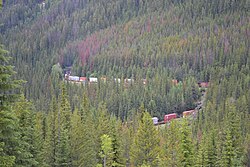Spiral tunnel
The Spiral Tunnels are two spiral tunnels on the transcontinental railroad line of the Canadian Pacific Railway (CPR) in the Canadian province of British Columbia . They are east of Field Parish and west of Kicking Horse Pass , which forms the watershed in the Rocky Mountains , in Yoho National Park . Internally in CPR, the section in which the tunnel is located is referred to as the Laggan Subdivision .
When the tunnels were opened in 1909 , they were considered a technical masterpiece and considerably defused the steep section that had been used up until then . The new route extended the route and the average gradient sank from 45 ‰ to still above average 22 ‰.
history
Construction of the route and construction of the Big Hill
In 1884, the CPR construction teams reached the Kicking Horse Pass. On the first six kilometers west of the 1627 meter high pass, the terrain drops 350 meters in the direction of Field. There was no way to artificially extend the route through Kicking Horse Canyon or Yoho Valley to reduce the incline. To save time and money, the tracks were laid in as straight a line as possible; as a result, the route had an average gradient of 45 ‰. This was four times higher than the maximum gradient recommended for railway lines at the time. Even today, railroad lines are seldom steeper than 20 ‰.
The railroad workers called this risky section Big Hill . For the uphill road to the east stood in Field special steam locomotives, so-called Pusher , slide ' ready to increase the driving force. The working conditions were extremely tough. In winter there were frequent blizzards and the temperatures often fell below −30 ° C or even −40 ° C. There was always the danger of avalanches or landslides . Often the steam locomotives stood still due to overload or wagons detached themselves from the trains, which then dashed downhill and derailed.
Construction of the spiral tunnel
At the beginning of the 20th century, with ever increasing traffic, it became inevitable that something had to be done to alleviate this bottleneck. The engineers were confronted with a lack of space because of the steep rock faces. The problem was solved by drilling a double loop with two spiral tunnels in the two mountain flanks based on the Swiss model . This made it possible to artificially lengthen the route and reduce the gradient to a bearable level.
The westward route first reaches the upper tunnel or tunnel No. 1 ( 51 ° 25 ′ 17.3 ″ N , 116 ° 25 ′ 8 ″ W ), as the railway workers call it. This is 992 meters long, rotates 288 ° in Cathedral Mountain and ends 15 meters lower. The route now runs northeast over the Kicking Horse River and reaches the lower tunnel or tunnel # 2 ( 51 ° 26 ′ 9.7 ″ N , 116 ° 24 ′ 12.7 ″ W ). In this 891-meter-long tunnel, the route in Mount Ogden turns 226 ° and then leads 15 meters further down towards the west. The route leads a total of three times (at different altitudes) through the valley and crosses the river four times.
The tunnels had to be drilled in highly sophisticated crystallized limestone . The hardness and fragility of the rock changed every few meters, which made the construction work considerably more difficult. In addition, there were water ingresses, the altitude (around 1500 m above sea level) and harsh winter weather. This made the already tough working conditions even more difficult.
By building the spiral tunnel, the maximum gradient of the route could be reduced significantly. The spirals extended the route by 12.5 kilometers. Thanks to these improvements, only two locomotives had to be used instead of the previous four. These could also pull longer trains, which significantly reduced operating costs.
The construction of the spiral tunnels increased safety on this section of the route, but the route is still not completely accident-free. Most recently, a train traveling west to Vancouver had an accident on February 4, 2019. On the section between the upper and lower spiral tunnels, two of the train's three locomotives and 99 of the 112 cars derailed. The train crew consisting of three people was killed in the accident.
literature
- Christoph Mertha, Frank N. Nagel u. a .: Spiral Tunnels , in Frank Norbert Nagel Ed .: Canada. From Acadia to the Yukon. Books on Demand , Norderstedt 2013, pp. 162 - 167 (available in Google books , with ill.)
Coordinates: 51 ° 25 ′ 38.3 " N , 116 ° 24 ′ 57.7" W.
See also
Individual evidence
- ↑ Laggan Subdivision , (English)
- ↑ Fatal train derailment: A closer look at what happened that tragic day. CBC , February 6, 2019, accessed March 13, 2019 .


